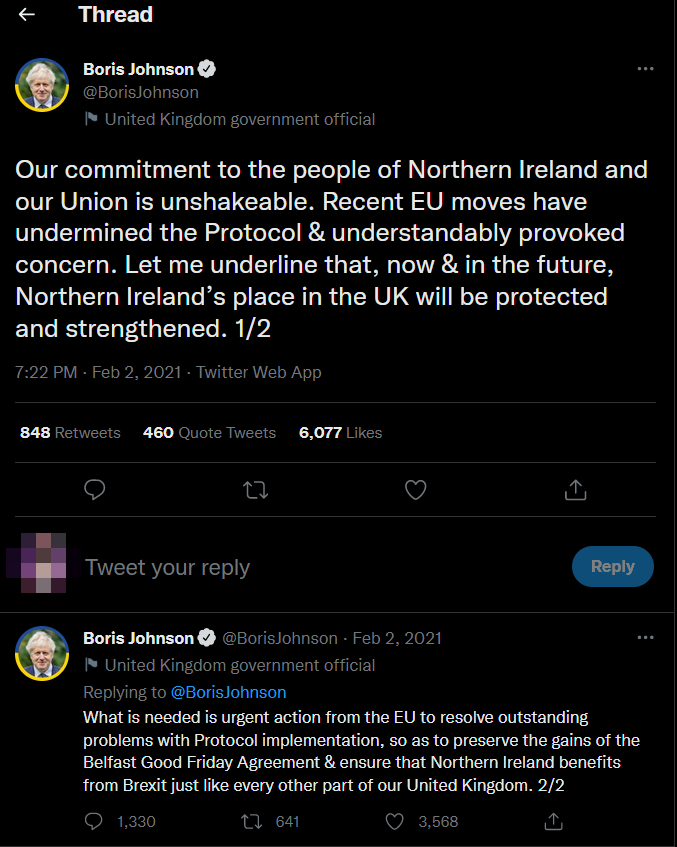On the 23rd June 2022, the Government introduced the The Northern Ireland Protocol Bill into the House of Commons.
In the Governments own words “It aims to fix parts of the Northern Ireland Protocol, restore stability and protect the Belfast (Good Friday) Agreement”[1]GOV.UK: The Northern Ireland Protocol Bill.
I try to be objective in these articles but I’d just like to point something out: What is there to fix? As we’ll see, the Northern Ireland protocol was agreed by, and signed off by, the very government that is now saying it’s not fit for purpose. Additionally, if it were so bad, how could the EU Commission sign off on it?
Anyway, on with the unbiased reporting of what’s going on (although I may interject occasionally due to the sheer ridiculousness of it all.)
Why Is There An Issue?
Northern Ireland sits in an anomalous area that has caused of lot of headaches due to Brexit.
If it were just mainland Britain that had withdrawn the from the E.U we could simply put our borders at the coastline and have customs checks at our ports and airports.
But, because Northern Ireland has a border with an E.U country and the UK has pulled out of the customs union, single market and Northern Ireland and Ireland aren’t part of the Schengen Area [2]Axa: Which countries are in the Schengen Area ? (which allows for free movement between countries) an issue has occurred.
Ordinarily, a border would be introduced between Northern Ireland and Ireland in order to check goods (and I guess by extension, people) travelling from the UK into the Eurozone and vice versa.
The problem is, they can’t do that.
Since Irish independence and then the establishment of a “common travel area” in 1922 [3]Citizen’s Information: Common Travel Area between Ireland and the UK, there has been an agreement for pretty much passport free travel between the two countries.
Additionally, on top of this the Good Friday Agreement codified into law that there would be no “hard border” – that is one requiring checks & controls between the two countries. This is legally binding under international law and went into effect in 1998 [4]Wikipedia: The Good Friday Agreement.
What Is the Northern Ireland Protocol?
In order to get around the fact that no border can exist between Northern Ireland and Ireland – which means there is no border between the U.K and the E.U – a variety of solutions were looked at.
These included any goods being moved to or from Northern Ireland being checked at Liverpool (or similar ports) effectively putting a border in the U.K, a border in the Irish sea and some other more “eccentric” ideas.
Theresa May’s government proposed the Northern Ireland Backstop (also confusingly referred to as the Northern Ireland Protocol and the the Irish backstop).
The backstop was finalised in 2018 and proposed that Northern Ireland legally retain some elements of the Single Market and customs union until a more suitable and permanent solution could be found.
The backstop would remove the need for “hard” borders between Ireland and Northern Ireland and would apply indefinitely unless The UK and EU could agree and ratify another solution[5]Wikipedia: Irish Backstop.
There were also other provisions covering freedom of movement, protections for E.U workers in the U.K and no checks on goods moving north and south of the Irish border.
The backstop was agreed by the UK and EU and it was then sent to Parliament at Westminster to be agreed and therefore become part of the Brexit withdrawal agreement.
It was voted down.
Three times.
Off the back of these defeats, Theresa May’s government received a call for a vote of no confidence which she survived with the worst result in parliamentary history (until Boris Johnson’s vote of no confidence in June 2022[6]The Guardian: Boris Johnson no-confidence vote: prime minister wins by 211 to 148 but 40% of Tory MPs fail to back him).
May’s government limped on but it was clear that they would not be able to pass the Irish Backstop through Parliament and she tendered her tearful resignation to the nation on 24th May 2019[7]BBC News: Recap: Leadership candidates emerged as May resigned which would then come into effect on the 7th of June, 2019.
There were many vying for the position of Prime Minister, but the man who came out on top was Boris Johnson with Conservative party members swayed by his “no nonsense” approach to Brexit.
Johnson became PM on the 24th July 2019 and in order to prove he had the nation’s backing giving him a mandate to lead the Brexit negotiations on the 24th October 2019 he called for a snap election[8]Boris Johnson calls for UK election on December 12, with the election to be held on 12th December that year.
During his election campaign, Johnson claimed that he had an “oven ready Brexit deal” stating:
“After 3 and a half years, it was perfectly obvious to me this Parliament is just not going to vote Brexit through, there are too many people opposed to Brexit who want to frustrate it. The only thing we can really do now is go to the people, go to the country, lets get this thing done. We have an oven ready deal, let’s put it in the microwave, as soon as we get back after the election on 12 December.”[9]The Sun: DO OR PIE Boris Johnson vows Brexit deal is ‘oven ready’ and he’ll get Britain out by January as he launches election campaign
Sticking with the cooking metaphors, at the launch of the election campaign Johnson said of the deal:
“Whack it in the microwave, gas mark… I’m not very good at cooking… gas mark four. Prick the lid. Put it in, and then we can get on… we can put this deal through Parliament.”[10]Yahoo News: What Boris Johnson promised about ‘oven-ready’ Brexit deal before general election
Johnson’s deal was to keep only Northern Ireland aligned with the EU on goods (including food & plant safety) and a few other “minor” points[11]The News Statesman: What is the Northern Ireland Protocol?
Unlike May, Johnson managed to get his agreement through both Houses of Parliament as his deal kept more control over the majority of the UK and it received Royal Assent.
On the 24th January 2020, just 7 days before the date the UK was due to begin the process to formally leave the EU, Johnson signed the Brexit Withdrawal Agreement into UK law.
The UK then entered a transition period where it was still governed by EU rules and regulations and this would last until Midnight on the 1st January 2021 when the UK would officially leave the EU.
The problem was, that The DUP (Democratic Unionist Party) in Northern Ireland weren’t exactly happy that they were going to be treated differently to the rest of Great Britain as there was effectively now a border going to be placed in the Irish sea (although Johnson had promised no border anywhere so….)
So That Was It Then, Brexit Done?
Of course, even though the agreement was signed, there was still more to do – many “t’s to cross and i’s to dot” during the transition period as the exact details were worked out.
Lord Frost was the government’s chief Brexit negotiator from 2019 whose remit was to keep in place the free trade deals the UK enjoyed with the EU while curtailing the influence of legal and governmental bodies such as the European Court of Justice.
Formal trade negotiations began on 31st March 2020 and were agreed on the 24th December 2020 after 10 gruelling rounds of negotiations[12]Wikipedia: Lord Frost.
Oven Ready Deal? Still In The Freezer More Like
Even though trade negotiations were well under way, cracks were beginning to appear in the Agreement.
On the 3rd September 2020, not even 9 months after the agreement was signed, it was being rumoured that Boris Johnson was looking into rewriting the Withdrawal Agreement completely[13]Sky News: Brexit: Changing the Withdrawal Agreement – Sky News experts give their views.
This was the first major indication that the Government wasn’t happy with the Withdrawal Agreement and was willing take drastic measures in order to shape the Agreement to their will and not necessarily what they had signed off and agreed to.
It’s important to remember at this point that Johnson had signed a legally binding agreement, in good faith, and that this was now recognised under international law.
A few days later again in September 2020, the Government looked to introduce the “Internal Market Bill” which mandated how power was shared once the withdrawal went through and this bill would override parts of the existing and ratified Withdrawal Agreement[14]BBC: Brexit: UK to unveil planned changes to Withdrawal Agreement.
A reminder again that the Withdrawal Agreement was “oven ready” and signed into law by the man who was now saying it essentially wasn’t fit for purpose.
Some commentators stated that it was a mere threat on Johnson’s part in order to ensure that Frost’s negotiations finished on time and with a favourable outcome as they did not want a “No-Deal” Brexit which was still a possibility at this stage.
But as the Internal Market Bill became law on the 1st January 2021[15]GOV.UK: UK Internal Market Bill becomes law , that shows it wasn’t a threat but something that would be acted upon.
After the conclusion of the Trade deal talks, Frost was then made “Chief Negotiator of Task Force Europe”, a cabinet office post that oversees various departments negotiating with the EU.
However, all was not rosy in Task Force Europe and on the 19th December 2021, Lord Frost tendered his resignation.
“I have led our EU exit process for the two and half years since you became Prime Minister. In those years we have restored the UK’s freedom and independence as a country and begun the process of building a new relationship with the EU…
Brexit is now secure. The challenge for the Government now is to deliver on the opportunities it gives us. You know my concerns about the current direction of travel. I hope we will move as fast as possible to where we need to get to: a lightly regulated, low-tax, entrepreneurial economy, at the cutting edge of modern science and economic change. Three hundred years of history show that countries which take that route grow and prosper, and I am confident we will too.”[16]GOV.UK: Lord Frost’s resignation letter and the Prime Minister’s response
After Frost’s resignation, Liz Truss was then appointed to the role of “Chief Negotiator of Task Force Europe”.
And that’s where the wheels started to really come off.
What Is The Problem In Northern Ireland?
The DUP (Democratic Unionist Party) are still not happy about the proposed sea “border” and as a result are refusing to form a power sharing government in Northern Ireland.
Under the terms of the Good Friday Agreement, the government must have a representative from both parties with the highest election results as First Minister and Deputy First Minister.
Sinn Féin were the biggest party at the election so they put forward Michelle O’Neill as First Minister.
Due to the issue of Brexit The DUP, runners up in the election, are refusing to name a Deputy First Minister so a power sharing government cannot be formed[17]BBC News: How does Northern Ireland’s power-sharing government work?.
This isn’t the first time this has happened, the longest suspension was between 2002 and 2007, and the most recent suspension was between 2017 and 2022.
When the government is suspended, Northern Ireland is run from Westminster although there are certain understandings between the two countries about what legislation can be passed and what Westminster can reasonably do.
In Liz We Truss
Now I’m not saying that the way to make a name for yourself in International Politics is to take a perfectly viable and legally binding international agreement and just tear it up but…. that’s just my personal opinion.
In Northern Ireland, the DUP are using the unique political situation in the country to blackmail Westminster into doing their bidding and get them to force the Northern Ireland Protocol Bill through Parliament[18]The Guardian: DUP rebuffs UK appeal to restore power sharing in Northern Ireland.
And that’s where Liz Truss comes in.
Truss introduced the “Northern Ireland Protocol Bill” on Monday 27th June for a second reading in the House of Commons[19]ITV News: What happens next with the NI Protocol Bill after it passes first House of Commons vote?.
You can read the full transcript from the reading here on the UKPOL archives.
It passed 295 to 221 – a majority of 74 and will now go to the committee stage for amendments[20]Parliament.UK: Northern Ireland Protocol Bill.
The bill with overturn a great deal of the existing Northern Ireland Protocol legislation set out in the Withdrawal Agreement.
Speaking to the BBC, Truss justified the move saying:
“People deserve to have a government, we have published this bill which does deliver for all the communities of Northern Ireland… [and Power sharing should resume] as soon as possible”
The Government argue that the bill will make the flow of goods from Great Britain to Northern Ireland easier.
It’s important to point out that 52 of 90 members of the Northern Ireland Assembly[21]Wikipedia: Northern Ireland Protocol Bill, or 57%, are against the bill, as is Irish Taoiseach (Prime Minister) Micheál Martin.
The EU have also reminded the Conservatives that would be a breach of international law. This could lead to sanctions, fines and even a trade embargoes from multiple countries.
So why is Truss so adamant the bill goes through?
Look To The Past To See The Future
The first step in the chain is to look at the elevation of the DUP in terms of political power.
In 2017, Theresa May called a snap election and lost the Conservative majority. As a result, in order to form an effective government, she made a pact with the DUPs 10 MPs[22]BBC News: https://www.bbc.co.uk/news/uk-northern-ireland-politics-44397110.
The pact related to financial support, upholding the Good Friday Agreement[23]Wikipedia: as well as setting up a committee to oversee the agreement.
It’s not a stretch then to see that the DUP feel that they have pull in the halls of Westminster, or should have a say that has more pull than their majority Assembly counterparts – after all, Brexit would never have “got done” if the DUP hadn’t helped the Conservatives win the 2017 General Election.
It’s All About The Optics
The second step is to look at Johnson and Truss themselves.
Johnson and Truss (Foreign minister at the time of writing) want to look powerful on the International Stage and Brexit is hampering these aspirations.
We can see from recent trips by Johnson to Saudi Arabia, Rwanda, Germany and Ukraine[24]Wikepida: International Prime Ministerial Trips Made By Boris Johnson that he wants to be seen as a global leader who can deal with the “big boys”. Therefore ceding to a ruling by the EU – even if he wrote it, agreed to it and signed it into law – isn’t a good look for him.
Similarly, Truss knows that at some point Johnson will step down – whether that will be by choice or due to yet another scandal is beside the point, he will go (although apparently not until 2030 if he has anything to do with it[25]Huffington Post: Boris Johnson Says He Aims To Be Prime Minister Into The 2030s) and she is vying for the top spot to replace him.
Give Red Meat To The Masses
The final link in the chain is the sheer number of scandals bombarding the Conservative party.
We’ve had PartyGate, CarryGate, WallpaperGate, Pub landlords being given PPE contracts, not to mention the billions spent on PPE that couldn’t be used, £37 billion on a failed test & trace system, £900,000 spent on a paint job for Johnson’s plane[26]The Guardian: Paint job on Boris Johnson’s plane will cost taxpayer £900,00, lost phones, deleted messages, dodgy peerages, donations from Russians, porn in parliament, second jobs and lobbying for contracts, MPs accused of rape or convicted of sexual assault – not to even mention the thousands and thousands of unnecessary deaths from COVID-19.
And many, many more – and more to come I am sure
Johnson needed a plan to rile up his base – the Pro-Brexit hard-liners within the party, and those members of the public who still believe Brexit is working and want to “stick it further” to the EU.
Setting Up The Fall Guy/Gal
The best part of the plan? If it all fails, Johnson has the perfect stooge in Truss to take the fall. After all, she’s the face of the Northern Ireland Protocol Bill and has pushed it heavily on social media and in the press – these tweets are all just from just two days:
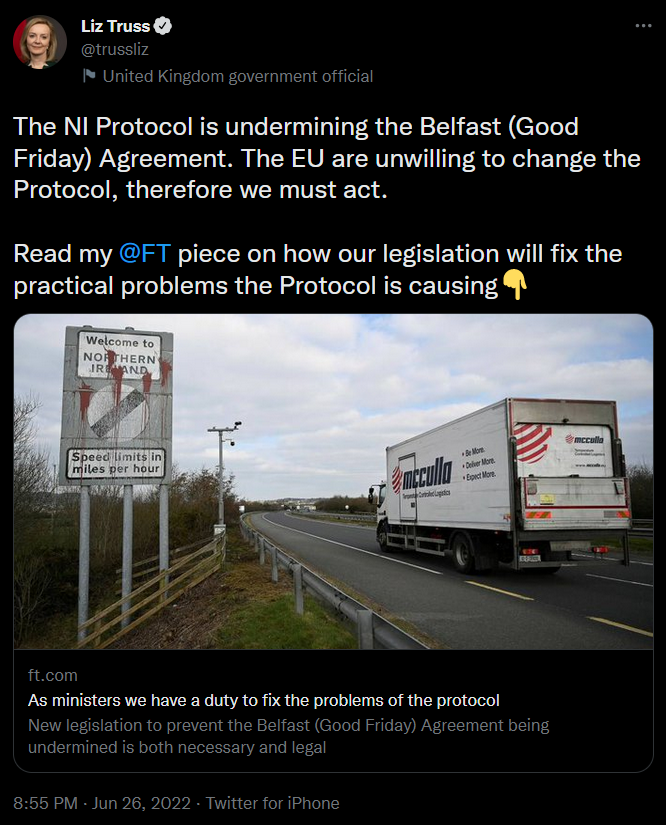
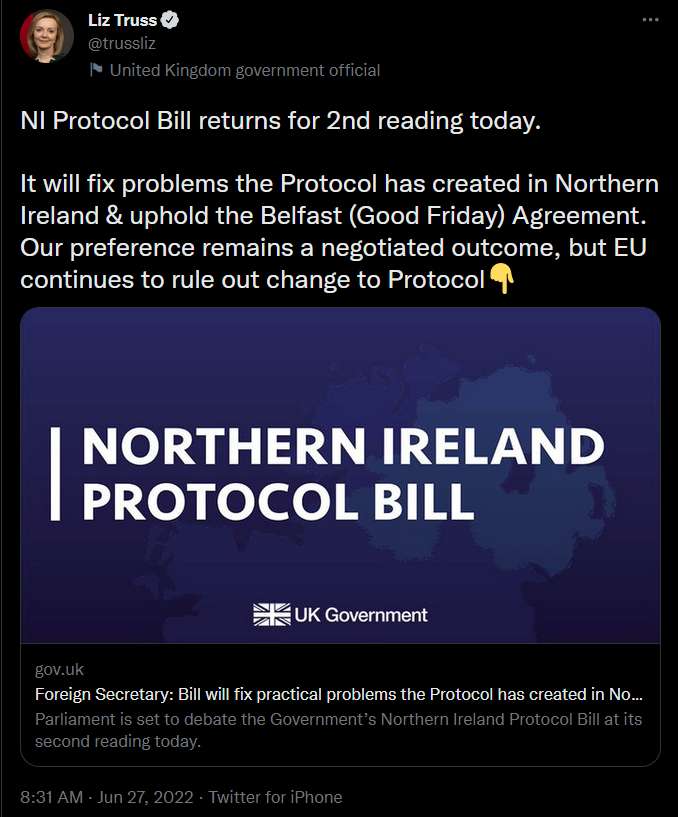
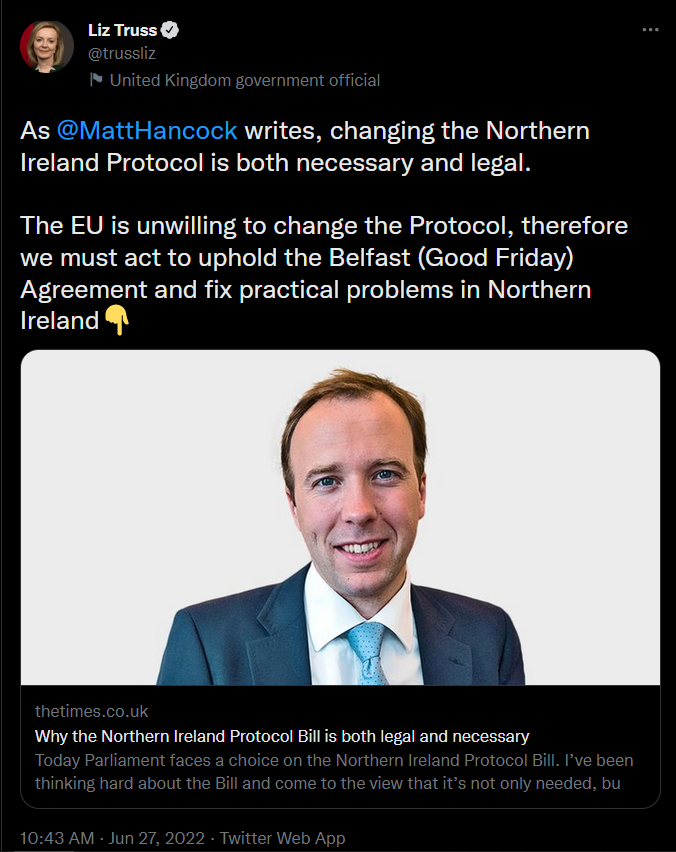
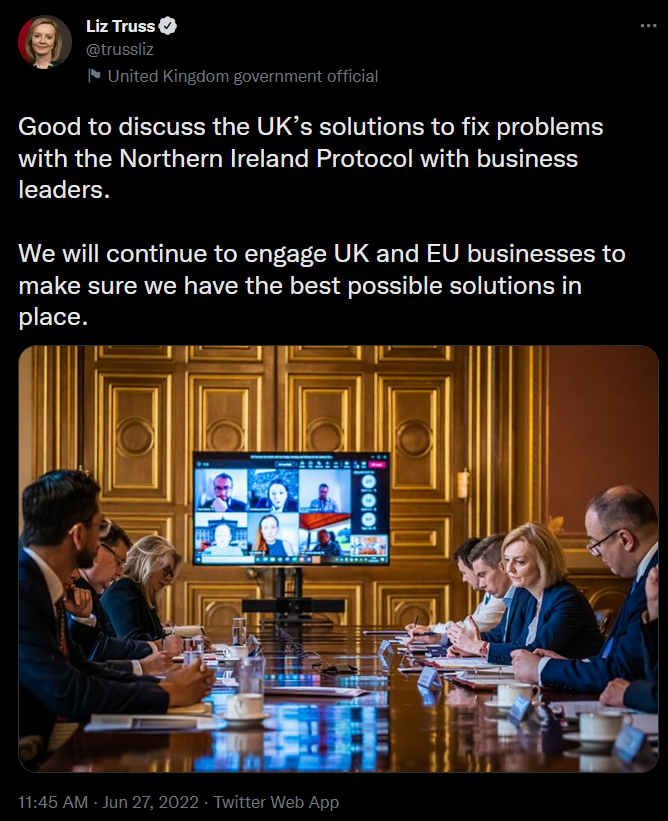
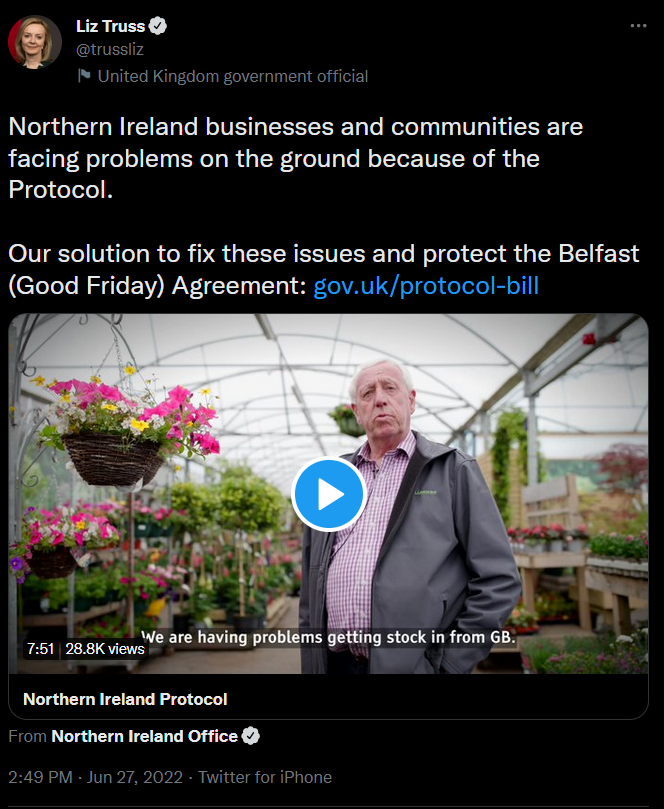
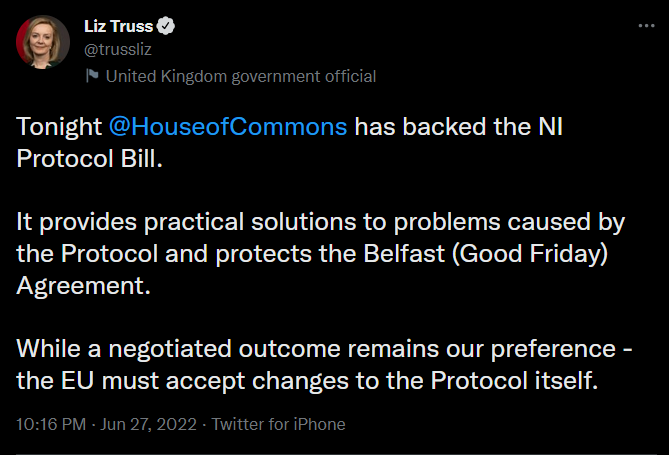
I note with interest that Boris Johnson didn’t tweet at all about The Northern Ireland Protocol Bill and the latest he mentions Northern Ireland is May 18th when talking about the Assembly
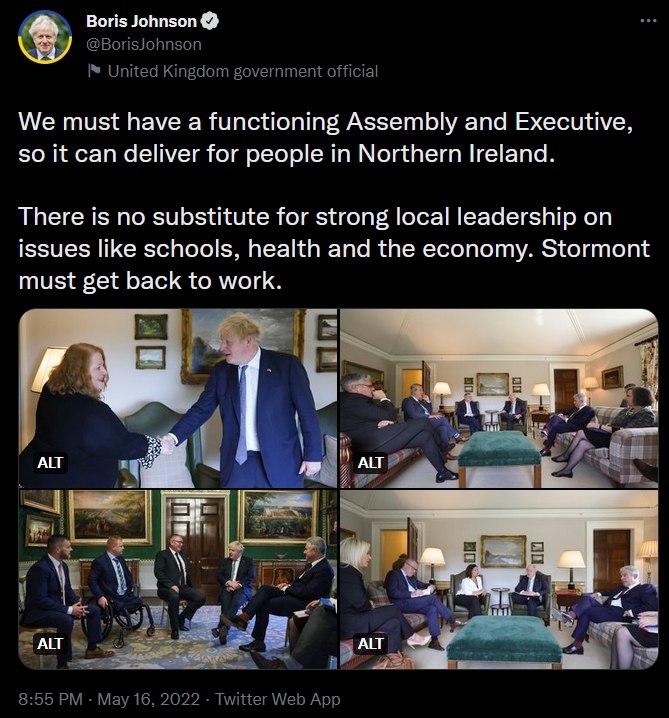
In fact when you search for similar wording that Truss uses, nothing comes up at all apart from one message sent back in February 2021 that mentions protocol – telling, don’t you think?
We’ll cover the EU’s “undermining of the protocol” when we discuss Article 16 later.
A search for both “protocol bill” or “N.I protocol bill” yield no results at all:
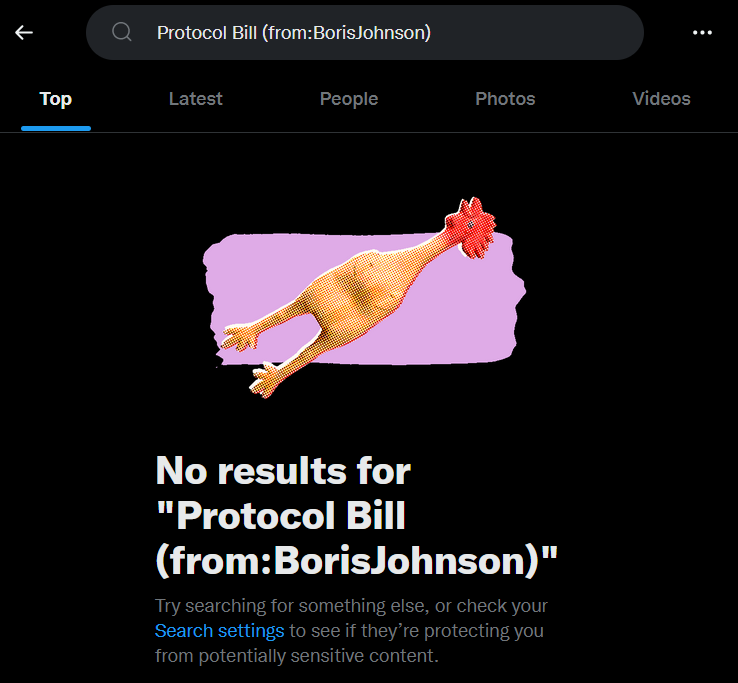
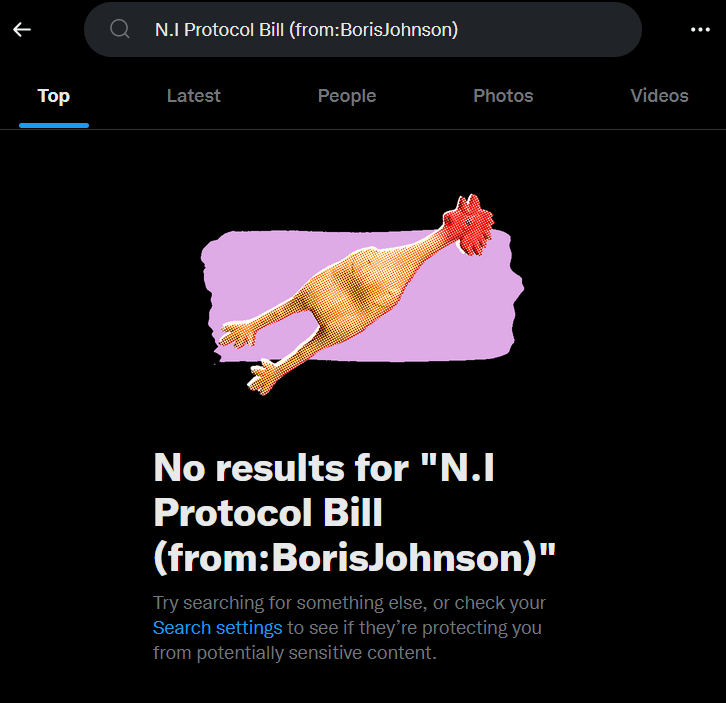
I feel it only right to add that Twitter search can be a bit temperamental at the best of times but for it to find nothing after the 18th of May 2022 for Northern Ireland is strange given the circumstances.
That being said, if The Northern Ireland Protocol Bill is so very important and the current way of doing things is ruining the lives of all those living in Northern Ireland, wouldn’t the Prime Minister mention it at least once in the past month?
Introducing The Northern Ireland Protocol Bill Is Legal, Right?
No, not in the slightest!
Well, it is in UK law itself, but not when it comes to wider issue of the EU and the Withdrawal Agreement.
As we’ve seen, the UK signed the Withdrawal agreement into law in January 2020. This made it a legally binding agreement – a contract if you will – between the UK and the EU.
The only way it can be changed is if you go back to the negotiating table – and why would the EU want to do that? As far as they are concerned everything was agreed and signed off two-and-a-half years ago.
The Government are trying to get around this fairly large stumbling block by invoking what is called the “Doctrine Of Necessity”.
I’ve already covered the Doctrine of Necessity before here so I won’t go into it in too much detail but the basics are:
If a Country/Nation State is in a “state of peril” – ie. there’s war, famine, plague or undue harm is being done to your citizens etc. then they are allowed (under certain circumstances) to ignore international law in order to remedy the “state of peril” they’re in.
As an example (and reminder that I am not a lawyer so take this is a pinch of salt, obviously):
Your country is experiencing a drought which has led to famine. A neighbouring country has a surplus of food and offer it to you. The problem is, they’re under a trade embargo due to international sanctions. You’d be able to break these legal sanctions as the lives of your citizens are in immediate peril.
What you couldn’t do though is to harvest all the food in your country, sell it off to someone else and leave nothing for your citizens thereby causing the famine yourself, you would not be able to break international law in this case.
Just to clarify again: If you put your own country in “peril” you can’t impose the Doctrine of Necessity. It can not be applied due to your own actions or inactions.
The Government are trying to say that the Withdrawal affects on Northern Ireland were unforeseen and therefore the Doctrine of Necessity applies[27]GOV.UK: Northern Ireland Protocol Bill: UK government legal position . The problem is that several documents produced by the Government themselves show that they were aware of this issue, there are also many additional publications by legal experts, economists and more that state that this could be a by-product of the Withdrawal Agreement.
The Government knew and therefore they brought the “peril” on themselves.
Why Not Just Invoke Article 16?
Article 16 of the Northern Ireland Protocol within the Withdrawal Agreement provides for “safeguards, rebalancing and governing procedures” for both the UK and EU if things aren’t working[28]European Movement Ireland: What is Article 16?.
To trigger Article 16 either the UK or EU must notify the other party they are doing so, and they then enter a consultation period.
This sound like the perfect solution to the problem, doesn’t it?
Well it is, and yet it still provides the EU with power and influence that the Government don’t want them to have.
If they were to invoke Article 16 and the EU proposed a reasonable solution then the Government would look weak.
It also doesn’t help that the EU actually already invoked Article 16 in January 2021[29]Sky News: What is Article 16 and why did the EU make a U-turn after triggering it?, during the height of the COVID pandemic, in order to ensure vaccines were being sent to the EU as a priority rather than the UK.
This did not go down to well and forced the EU into an embarrassing U-Turn and it may be that the UK government don’t want to make the same mistake.
Plus Article 16 is seen as a last resort so they may be keeping that card close to their chest for later on if they need it.
So What’s Next For The Northern Ireland Protocol Bill?
The bill still has to go though a committee stage, then a report stage and then back to the House of Commons for its third reading.
If it passes the third reading in the Commons (with any amendments made at committee stages) then it will be passed up to the House of Lords.
They could pass it straight away and in that case it goes off for Royal Assent after which it because codified in UK law or the Lords could request further amendments and then the bill would be caught in a game of ping pong between the Commons and Lords until it is either passed, pushed through or is dropped due to being out of parliamentary time.
The process isn’t overnight so the bill probably wouldn’t be passed for Royal Assent until the end of the year at the earliest.
There’s a bit more to it than that so I’ll be writing an article on this process in more depth as it’s a bit confusing so please sign up to the newsletter so you don’t miss out (sorry for the shameless plug!)
What’s Next For The UK If This Becomes Law?
Well, that’s the 64 million Euro question, isn’t it?
The EU could just let us get on with it but that sets a dangerous precedent if the UK wants to make further changes to the Withdrawal Agreement (or if another country decides to leave in the future).
There will undoubtedly be legal challenges although the question seems to be: where would they take place?
The Bill of Rights is progressing and this would essentially remove the UK from oversight from the European Courts.
This means that if the Bill of Rights is in law before the Northern Ireland Protocol becomes law then if the EU were to go to the European Court of Justice, the UK could (in the eyes of UK law) ignore any rulings made.
This of course would make relations between the EU and UK extremely difficult, along with other countries who would probably support the largest trading bloc in the World[30]EU Trade Commission: EU Position In World Trade.
Individual countries such as Ireland may also take the UK to court (even Northern Ireland might as they do not support the Bill) but again, where the case would be heard would be difficult to establish if the UK no longer recognises EU Courts.
The exact outcome remains to be seen and is heavily dependent on what happens to the bill after the third reading when it’s sent to the House of Lords and I do not think its passage through there will be as smooth as the Government thinks it will be.
Katy is the editor-in-chief of FlippingHeck.com a blog about Self-Improvement, Productivity and Small Business Tips. When she’s not working, she enjoys gaming, making music and Reviewing Things.


